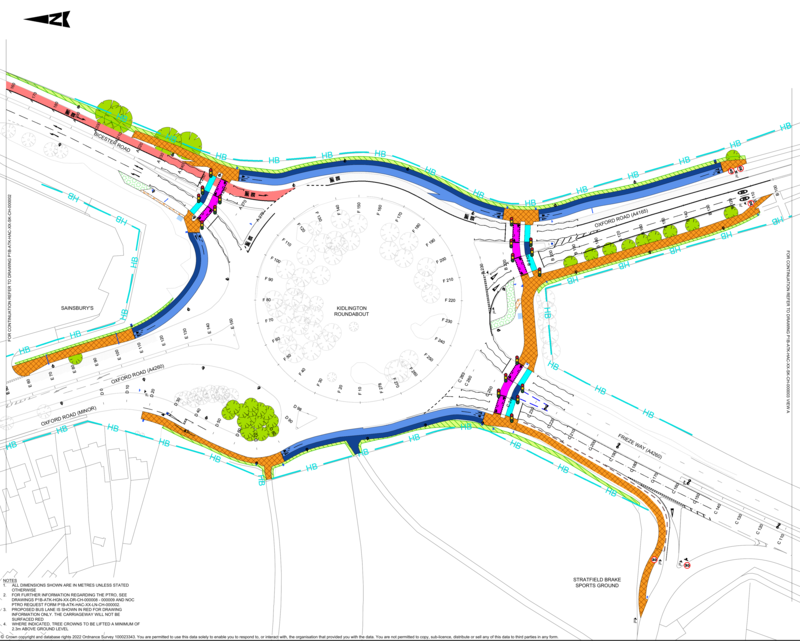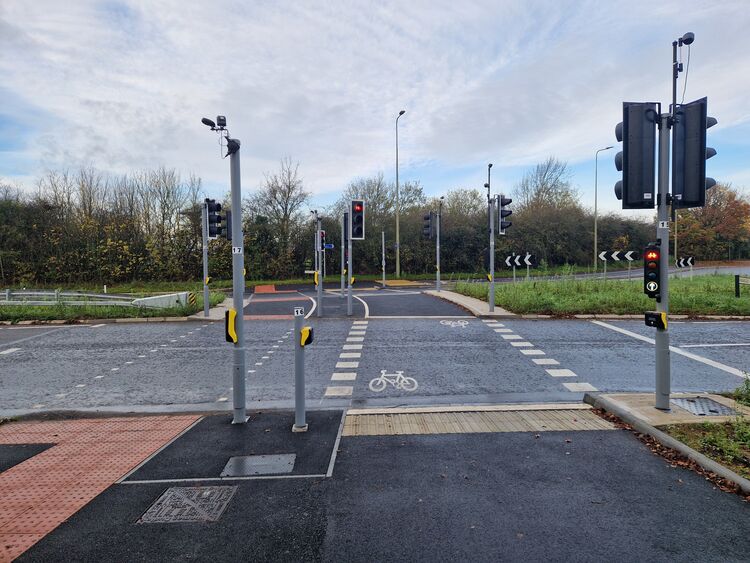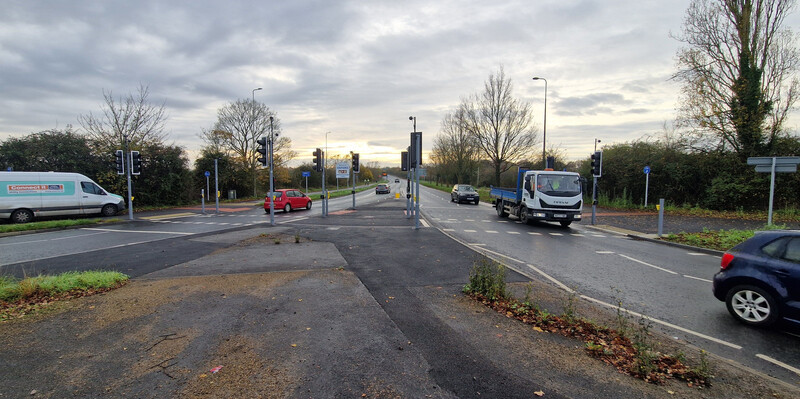In 2018, Andrew Gilligan wrote "Despite the huge numbers of cyclists using them, Oxford’s main roads and junctions are still laid out almost entirely for the benefit of the motor vehicle". Sadly this remains true, and though a few stretches of road have more or less decent cycling provision along them, there is still not a single Oxford junction actually designed for walking and cycling, rather than having minimal pedestrian provision and ad hoc features to support cycling tacked on as an afterthought. But if we venture a little out of Oxford, there is now one junction whose design really does take walking and cycling seriously, and which could be shown to others as a model. That is the roundabout just south of Kidlington, where Frieze Way and Bicester Rd connect with Oxford Rd.

Along with other active travel advocates, I criticised the original design for this roundabout, which was motor-traffic-centric and driven by old-fashioned "predict and provide" planning: it involved adding a lane to the roundabout (and removing part of the central island, along with eight mature trees) and had a shared-use path with staggered crossings for both walking and cycling. We had some input into the redesign, but the county planners deserve the credit for that - and for making sure the implementation and design details were right.
The roundabout has been dropped to 30mph and a two-way circulating cycle track and footway run around it, with two-stage signal crossings for pedestrians and straight single-stage crossings of each arm for cycling. There are state-of-the-art modern signals, which include cameras that will delay the motor traffic green if people are detected still crossing, and they have been programmed with low latency (the longest wait when I visited was 12 seconds). Some more confident people were cycling across without bothering to use the lights, which works well in low traffic periods and seems pretty safe given the excellent visibility. (This works like a non-priority Dutch-style roundabout, which would be normal in the Netherlands at an extra-urban location like this.) Crossing times are longer for pedestrians, since they involve two stages, but were still better than pretty much any signal crossing or junction in Oxford. And there are no signs that this is creating motor traffic congestion, even in peak hour, though that may be more of an issue if improved infrastructure and more housing results in more people walking and cycling here.
- "On balance it's a whole heap better and I like it. I've also used it as a pedestrian and again it's grand."
- the "lights … are speedy and convenient. However, quite often I can cross without them. Since it has been done I have not cycled on any of the roadway of the roundabout, which I sometimes used to do."
- "I tend to use the roundabout outside peak hours and it has worked very well for me. My only anxiety is when you exit the roundabout towards Oxford and drop into the bus lane: it requires a lot of care, especially if a taxi is approaching at speed, If there was an easier way to filter in to the bus lane it would be helpful. But in general, we are pleased with the outcome and the promptness with which the lights respond when we press the buttons"
On the actual roundabout itself, a site visit picked up only a few minor concerns: a loop to support cycle right turns across the Kidlington service road that should have had a smooth curved entry, not a right-angle turn, and two locations where kerb corners pose a hazard and should be champfered. People with larger cycles may have problems accessing the call buttons for the cycle crossing ("I was using the cycle crossing but the pedestrian button. Harder to use second cycle button on a cargo bike than first for pedestrians. As you have to poke the bike into the crossing slightly or past the crossing.") One major omission is a crossing of the Oxford Rd (north) arm, which is not a desire line at the moment but might become important if other routes are improved.
The much bigger problems we saw, and which were repeated in the feedback from people who use the roundabout regularly, related to the connections to and from the roundabout on the approach roads. The shared-use paths southwards on Oxford Rd are poor quality; Frieze Way lacks any foot or cycle infrastructure at all (and David Brain was killed cycling there early in 2024); the service road is hostile for cycling when there's any significant amount of traffic on it; the cycle track on Oxford Rd northwards is too narrow and has dangerous crossings of the entry and exit to the Sainsburys; and the Bicester Rd has no foot or cycle infrastructure on the west side and an overgrown shared-use track on the east side. On many of these routes people prefer to cycle in the bus lanes. But these problems are all potentially addressable: even Frieze Way could be changed to a single carriageway, freeing up space for a footway and cycle track.
The Kidlington roundabout is, in conclusion, one of the few genuinely first-rate pieces of active travel infrastructure in the county.



Wow only 12 seconds delay. Our push button crossing on. The Slade is 40 seconds most of the time - always during rush hour - and a minimum of 20 seconds.